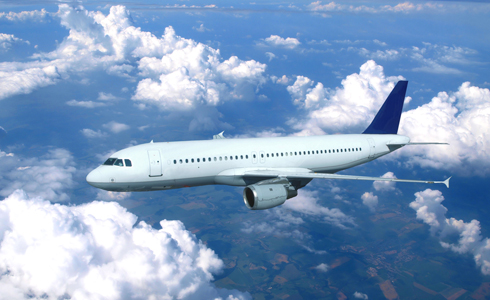"You could say that 2009 was a turning point marking on the one hand the rise of emerging market airlines and on the other the growing ambitions of these countries' aircraft manufacturers in a market hitherto dominated by Airbus and Boeing. This new competitive situation represents a major challenge for the European aircraft industry", says Karine Berger, chief economist at Euler Hermes.
How has the 2009 fall in air traffic affected players in the air industry?

Having held up well, the aircraft industry now needs to prepare for fresh competition
- Output has remained steady
Operating in long cycles, the aircraft industry has maintained its level of activity thanks to orders won before the onset of the crisis, representing six or seven years' worth of production. Although new orders plummeted by 70 percent in 2009 compared with 2008, they have rebounded by 50 percent YoY so far in 2010, reassuring aircraft makers of good prospects in the medium term. - The fall in manufacturers' profitability is not due to the crisis
Operating profitability (operating profit divided by total sales) of Boeing Commercial Airplanes went from 4.2 percent in 2008 to -1.7 percent in 2009 and that of Airbus Commercial from 8.7 percent to 1.5 percent. This decline is due to cost overruns caused by delays in development and production incurred by both constructors on certain programs, specifically the Airbus A380 and the Boeing 787. - Competition is expanding
The Airbus-Boeing duopoly is seeing its global dominance under threat in the medium term from the rapid growth of makers such as Canada's Bombardier, and more especially China's Comac, Brazil's Embraer and Russia's Irkout, particularly in the single- aisle, over 100-seat aircraft segment. - Innovation will be the deciding factor
In this more competitive environment, manufacturers will have to intensify their efforts to respond to airlines' demands in terms of fuel consumption and carbon emissions.
"This challenge revolves around the choice of engines and the use of composite materials to make planes lighter. It comes on top of the industry challenge posed by the forced pace of manufacturing outsourcing, which is at the root of Boeing's current difficulties with the B787", stresses Bruno Goutard, sector adviser with Euler Hermes.

Faced with the rising power of low cost airlines in regional transport, the traditional carriers need to come up with a new growth model
Airlines'1 performances closely reflect regional economic trends
- China and the Middle East escaped the 2009 collapse in traffic
The intrinsic growth of both regions translated into a sharp rise in passenger volumes, with China up by 11.6 percent and the Middle East by 24 percent. Fuelled by domestic demand, the Chinese carriers posted net margins of 3.5 percent, while the leading Middle East airline came in at 8.5 percent. - European and American airlines were hit badly
In the United States, the 6 percent drop in passenger traffic for our sample1 in 2009 had a negative impact (-4 percent) on net margins of the major carriers, which reacted by cutting capacity, including, for the first time, in the low cost segment. In Europe the drop in traffic was less marked (-0.7 percent) but lower sales in the premium - American airlines are penalized by their indebtedness
In combination with the decline in profitability, and thus in free cash flow, airlines' indebtedness could become difficult to sustain. "Comparing their gross debt with their free cash flow, it would take more than 18 years for the American carriers to repay their borrowings - twice as long as the European companies", Bruno Goutard explains.
Western airlines back in profit
- Air traffic has picked up in 2010 in all regions
The recovery applies to both passengers (up by 7.7 percent) and freight, which has rebounded by 20 percent worldwide. Asia-Pacific and the Middle East remain the most dynamic regions. - US airlines back in profit from 2010
The adjustments made to capacity in 2009 and the recovery in premium sales have contributed to this recovery (+2.5 percent). The various mergers and alliances that are in progress should bolster airlines' profitability in 2011, thanks to improved control of offerings and costs. - European airlines recovering thanks to cost reductions
The cost reductions carried out in 2009-2010, notably in workforce, together with adjustments made to offerings, will enable airlines to return to profit in 2010 and 2011, with net margins of 1 percent and 2 percent respectively. - One factor that is very difficult to control: the price of aircraft fuel
In 2008, the peak in oil prices led to record losses of 16 billion US dollars for the world's airlines. In 2009, the sharp correction in the oil price (40 percent down on 2008) limited losses, but this parameter, which is central to operating costs of all airlines, remains difficult to forecast. - Faced with the rising power of low cost airlines in regional transport, the traditional carriers need to come up with a new growth model.
Air industry set to remain under pressure in a widening market
- Western aircraft builders are going to have to defend their market shares and their margins from attack by competitors who are closer to the growth markets and likely to benefit from national preferences.
- Airlines, which are highly sensitive to short-term ups and downs in the economy, remain only marginally profitable, and need to become more flexible.
"The aircraft construction and airline industries retain their structural differences. The regional factors and short cycles that are characteristic of air transport make this sector highly sensitive to short-term fluctuations in the economy. Airlines seek to ensure their financial stability through greater operational flexibility. As for the aircraft construction industry, the length of development, production and sales cycles makes it much less sensitive to short-term effects; so the main challenge for aircraft manufacturers is to share programs risks with equipment suppliers in order to reduce the industrial uncertainties which so penalize their financial performance", Bruno Goutard concludes.
15 Euler Hermes concentrated its analysis on the major airlines in each region: Delta Airlines, United Airlines, Continental Airlines, American Airlines and US Airways in the United States; Air France-KLM, Lufthansa and British Airways in Europe; Air China, China Southern Airlines and China Eastern Airlines in China; Emirates in the Middle East.
As with all content published on this site, these statements are subject to our Forward Looking Statement disclaimer.
Link to the disclaimer